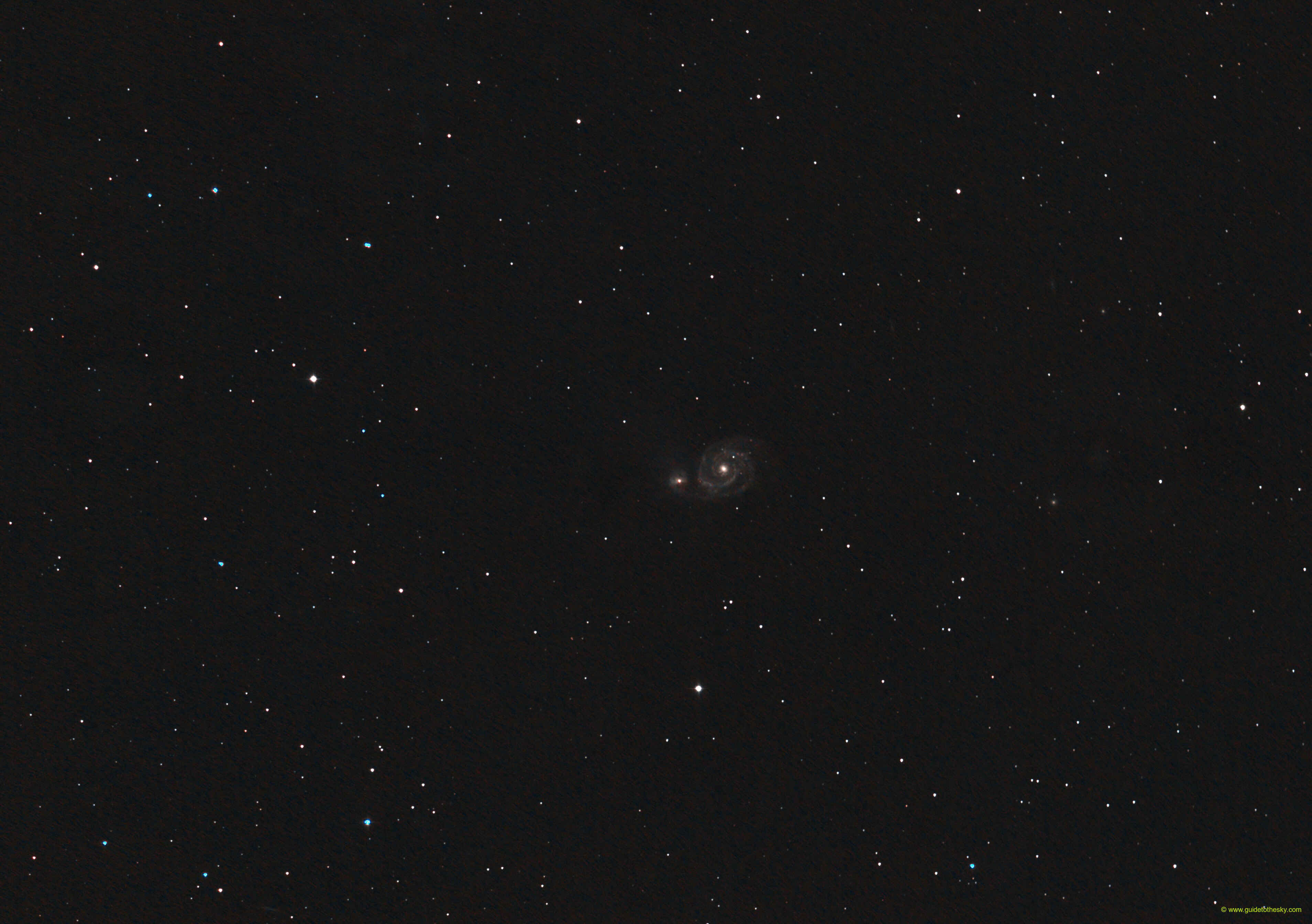Messier 51 - Canes Venatici

Dista {{ object[0].M51.mesDistances[0].dist }} {{ object[0].M51.mesDistances[0].unit }} de La Tierra. Basta echar un vistazo a su estructura espiral de brazos bien abiertos que justifican su nombre.
M51 Tiene historia: en 1845 Lord Rose fue el primero en detectar su estructura en espiral, siendo la primera de esta clase en ser detectada.
M51 es además una galaxia doble: el perfecto ejemplo de galaxias en colisión o interactuando: NGC 5194 y NGC 5195. En fotografías de alta exposición pueden verse estrellas "desparramadas" debido al efecto marea por la interacción de ambas galaxias, se habla de tres estructuras saliendo de NGC 5195 en dirección opuesta de la espiral principal. En realidad, M51 se refiere a las 2, y son referidas a veces como M51a y M51b.
M51 como M101, da su nombre a un grupo de galaxias: el grupo de M51 al que pertenece también M63.
Otras varias galaxias podemos ver en el campo, entre ellas 5229, que también pertenece al grupo de M51, de la 15 Magnitud. En cambio, NGC 5198 de la 13ª, mucho más distante, se estima que está a 39.6 Mpc (2011MNRAS.413..813C)
M51 - Galaxia del remolino - en la IA
Messier 51, also known as the Whirlpool Galaxy (and NGC 5194/5195), is a captivating and well-known spiral galaxy located in the constellation Canes Venatici. It's a favorite target for both amateur and professional astronomers due to its beautiful, clearly defined spiral arms and its ongoing interaction with a smaller companion galaxy.
Here's a breakdown of key information about Messier 51:
Key Features:
- Spiral Galaxy: It's a classic example of a grand-design spiral galaxy, meaning its spiral arms are prominent and well-defined.
- Interaction with NGC 5195: The Whirlpool Galaxy is gravitationally interacting with a smaller dwarf galaxy, NGC 5195. This interaction is believed to be responsible for the enhanced spiral structure of Messier 51. The gravitational tug of NGC 5195 is compressing gas and dust within Messier 51, leading to bursts of star formation.
- Distance: Estimated to be about 31 million light-years away from Earth.
- Size: Approximately 76,000 light-years in diameter, making it somewhat smaller than our own Milky Way.
- Star Formation: Messier 51 is a site of intense star formation, particularly in its spiral arms. Bright, young, blue stars are readily visible in images of the galaxy, marking regions where stars are actively being born.
- Supernovae: Several supernovae have been observed in Messier 51, providing valuable data for astronomers studying the life cycle of stars.
Why is it so well-known?
- Visual Appeal: Its spiral structure and the companion galaxy make it visually stunning in images and even through a telescope.
- Proximity: Relatively close compared to other galaxies, allowing for detailed observation.
- Astrophysical Significance: The ongoing interaction with NGC 5195 provides a unique opportunity to study the effects of galactic mergers and the triggering of star formation.
How to observe it:
- Telescope: A telescope is required to see Messier 51. A small telescope will show a faint, fuzzy patch, while larger telescopes will reveal more detail, including the spiral arms and the companion galaxy.
- Location: It's best observed from a dark location away from city lights.
- Time of Year: It is well placed for observation in the Northern Hemisphere during the spring months (April and May).
In Summary:
Messier 51 is a fascinating and beautiful galaxy that exemplifies the dynamic processes that shape galaxies. Its interaction with its companion galaxy provides a valuable case study for understanding galactic evolution and star formation. Its accessibility to amateur astronomers and its stunning appearance make it one of the most popular and well-studied galaxies in the night sky.
Más información sobre Messier 51 en NASA/IPAC.
Mapa alrededor de Messier 51
Otros identificadores de M51:
"[OKM2018] SWIFT J1329.9+4719" ,"[NKB95] N5194" ,"ILT J132952.71+471143.3" ,"PLX 3084" ,"4C 47.36A" ,"APG 85A" ,"APG 85" ,"BD+47 2063" ,"GB1 1327+475" ,"IRAS F13277+4727" ,"IRAS 13277+4727" ,"ISOSS J13299+4714" ,"KHG 1-C 5" ,"KPG 379a" ,"LEDA 47404" ,"M 51" ,"MCG+08-25-012" ,"NAME Whirlpool" ,"NGC 5194" ,"TC 827" ,"UGC 8493" ,"VV 403" ,"VV 1a" ,"VV 1" ,"Z 246-8" ,"[DML87] 671" ,"[H92] 27" ,"[LPS2002] 16" ,"[SLK2004] 853" ,"[T76] 85A" ,"[VDD93] 187A" ,"2MASX J13295269+4711429" ,"PLX 3084.00" ,"1RXS J132953.8+471143" ,"RX J1329.8+4711" ,"XMMU J132952.9+471140" ,"Z 1327.8+4727" ,"[CHM2007] LDC 867 J132952.69+4711429","[M98c] 132746.9+472716" ,"[VV2000c] J132952.4+471141" ,"[VV2003c] J132952.4+471141" ,"[VV2006c] J132952.4+471141" ,"[VV98c] J132952.7+471143" ,"[ZEH2003] RX J1329.8+4711 1" ,"UZC J132952.1+471144" ,"PSCz Q13277+4727" ,"2XMM J132952.5+471144" ,"[VV2010c] J132952.4+471141" ,"B3 1327+474C" ,"GB6 B1327+4727" ,"WB 1327+4727" ,"87GB 132747.8+472723" ,"WN B1327.8+4727" ,"BWE 1327+4727" ,"6C 132748+472801" ,"7C 132735.60+472604.00" ,"7C 132746.79+472722.00" ,"7C 132753.10+473032.00" ,"[CAB95] IRAS F13277+4727" ,"NAME Question Mark Galaxy" ,"NAME Whirlpool Galaxy" ,

